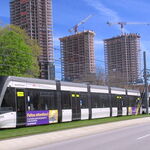[3] Mr. Eid, on behalf of Metrolinx, outlined that the Kitchener extension project is a large infrastructure project being undertaken in recognition of the importance of the Waterloo/Toronto innovation corridor. Metrolinx will be adding tracks, bridges, a new station at Kitchener, improvements to the existing stations, including an additional platform and new layover facility near Heritage Road, and a Rail-to-Rail grade separation. The property at issue in this inquiry is located adjacent to the Halton subdivision.
[4] Mr. Olbrycht, senior track engineer at AECOM, Canadian National Railway’s (“CN”) contractor, outlined results of the feasibility studies:
It was determined that a grade separation, flyover and two additional tracks is appropriate given the amount of existing CN rail traffic and what is projected from the Project. In particular, separation of GO transit and CN freight rail track was deemed necessary for the safety of the traveling public on the GO Line and CN operators.
[5] The end result, on the Reed lands: in order to increase Go Rail service to 15-minute, 30-minute and one-hour two way all day service between Union Station and Kitchener to respond to public demands for GO Rail service, it is necessary to construct a fly-over, to separate its tracks from CN, add two additional tracks, and to relocate the CN tracks to allow for the flyover.
[6] Mr. Olbrycht testified that, in addition, the southern tracks have to be flared as the tracks raise above grade in order to allow the trains to maintain a speed of 70 miles per hour. The speed of the trains and the minimum separation distance required by CN dictate the curvature of the track and the incline. “It is mathematically driven.”
[7] As to the impact on the Reed lands, the works proposed eliminates his crossing and he states the configuration of the takings render some of his remaining parcels difficult, if not impossible, to use.
[8] As to alternatives, there were none provided by the requestor. Mr. Olbrycht did testify they considered design options and costs. The grade separation and flyover were selected due to the existing volume of freight traffic on the CN rail and the projected traffic of GO trains. The flyover is preferred since it would allow GO trains to move freely from north to south, without conflict with CN traffic.
[9] The cost of the flyover structure compared to other options was also a factor in the determination of its preferred alternative.
[10] As well, “the topography of the Reed lands makes it an ideal location for a flyover due to a natural low point in the Reed land, since it allows the tracks to be elevated to a lesser degree, resulting in significant cost savings.”
[11] The evidence supporting the proposal and the need for the takings was in no way challenged in evidence. The impact on the Reed lands is considerable, but after considering all of the evidence and submissions the Tribunal concludes that the proposal presented by Metrolinx meets the test in the Act, and the summation of it as set out by the courts. The test in section 7(5) of the Act, and the summation of it as set out by the courts, is whether the proposed taking is “fair, sound and reasonably necessary in the achievement of the objectives of the expropriating authority.”




